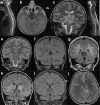Treatment Approaches for MOG-Ab-Associated Demyelination in Children
- PMID: 30671648
- PMCID: PMC6342853
- DOI: 10.1007/s11940-019-0541-x
Treatment Approaches for MOG-Ab-Associated Demyelination in Children
Abstract
Purpose of review: The purpose of this review is to summarize current understanding regarding the treatment of myelin oligodendrocyte glycoprotein antibody (MOG-Ab)-associated demyelination in children. Emphasis is placed on the unique obstacles we face when predicting the risk of relapse and the important implications of such challenges when planning treatment protocols.
Recent findings: MOG-Abs are consistently identified in a range of acquired demyelinating syndromes (ADS) in adults and children with a clinical phenotype distinct of MS and AQP4-Ab neuromyelitis optica spectrum disorder. Although initially thought to be associated with a benign disease, recent reports of children who are treatment-resistant and developed progressive disability over time raise important questions about how children with relapsing MOG-Ab disease should be managed. MOG-Abs are common in children with ADS with both monophasic and relapsing disease courses. Treatment of patients with MOG-Ab-associated demyelination includes management of acute relapses and chronic immunotherapy for those with relapsing disease. Emerging consensus supports distinction of treatment strategies from those typically used for relapsing remitting MS, and several groups debate whether to follow treatment protocols akin to those for AQP4-Ab NMOSD. A key challenge remains predicting the severity of the disease at onset. Collaborative international consensus to derive shared clinical evaluative platforms standardized biological and neuroimaging protocols which can be used clinically, and partnered research programs are required to advance personalized treatment for children with MOG-Ab-associated demyelination.
Keywords: Acquired demyelination syndromes (ADS); Acute disseminating encephalomyelitis (ADEM); Autoantibodies; Myelin oligodendrocyte glycoprotein (MOG); Neuromyelitis optica spectrum disorder (NMOSD).
Conflict of interest statement
Conflict of Interest
Yael Hacohen declares no potential conflict of interest. Brenda Banwell reports personal fees from Novartis, outside the submitted work.
Human and Animal Rights and Informed Consent
This article does not contain any studies with human or animal subjects performed by any of the authors.
Figures


References
References and Recommended Reading
Papers of particular interest, published recently, have been highlighted as: • Of importance •• Of major importance
-
- Hacohen Y, Absoud M, Deiva K, Hemingway C, Nytrova P, Woodhall M, Palace J, Wassmer E, Tardieu M, Vincent A, et al. Myelin oligodendrocyte glycoprotein antibodies are associated with a non-MS course in children. Neurol Neuroimmunol Neuroinflamm. 2015;2:e81. doi: 10.1212/NXI.0000000000000081. - DOI - PMC - PubMed
-
- Hennes EM, Baumann M, Lechner C, Rostasy K. MOG spectrum disorders and role of MOG-antibodies in clinical practice. Neuropediatrics. 2017. - PubMed
Publication types
LinkOut - more resources
Full Text Sources
Research Materials

